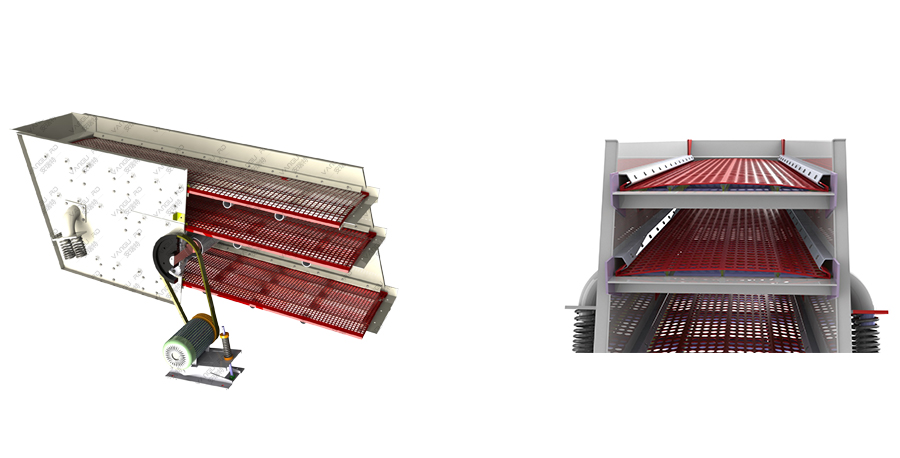9 Major Differences Between Circular Vibrating Screen and Linear Vibrating Screen.
Date:2024-07-05Introduction
There are many types of vibrating screens. According to the movement trajectory of the material, they can be divided into circular vibrating screens and Linear vibrating screens. Both types are commonly used screening equipment in daily production. Today we will compare and see the difference between the two.
Classification of vibrating screens
According to the material movement trajectory of the vibrating screen, it can be divided into:
Linear vibrating screen: The material moves forward in a straight line on the screen surface;
Circular vibrating screen: The material moves forward in a circular motion on the screen surface.
There is no essential difference in the style and structural composition of the circular vibrating screen and the linear vibrating screen. The material is screened by the vibration of the screen surface, but the different vibration tracks will directly affect the purpose of screening.
Working principle
1. Circular vibrating screen
The motor drives the eccentric block of the vibrator to rotate at high speed through the V-belt, generating a large centrifugal inertia force, which stimulates the screen box to produce a circular motion with a certain amplitude. The material on the screen is subjected to the impulse transmitted by the screen box on the inclined screen surface and produces a continuous throwing motion. When the material meets the screen surface, particles smaller than the screen hole are screened, thereby achieving classification.
2. Linear vibrating screen
Using the vibration motor as the vibration source, the material is thrown up on the screen and moves forward in a straight line. The material enters the feed port of the screening machine evenly from the feeder and passes through the multi-layer screen to produce several specifications of oversize and undersize, which are discharged from their respective outlets.
Differences and comparisons
1. Movement trajectory
The material on the circular vibrating screen moves in a circular motion, and the material on the linear screen moves forward in a linear motion.
2. Exciter
The circular vibrating screen is also called a single-axis vibrating screen because the exciter is a single shaft and works by an inertial motor. The linear vibrating screen exciter consists of two shafts and works by the principle of vibration motor excitation, so it is also called a double-axis vibrating screen
3. Blockage phenomenon
The material on the circular vibrating screen moves in a parabolic circular trajectory on the screen surface, so that the material is dispersed as much as possible, thereby increasing the material bounce force, and the material stuck in the screen hole can also jump out, reducing the blockage phenomenon.
4. Installation layout
The linear vibrating screen reduces the screen height with a small screen surface inclination angle, for convenience for the process layout.
5. Screen surface inclination angle
According to the particle size of the material, the circular vibrating screen can change the screen surface inclination angle, thereby changing the material movement speed along the screen surface and increasing the processing capacity of the screen machine. Generally speaking, the linear vibrating screen has a small screen surface inclination angle in production.
6. Material
Generally speaking, the thicker plates use circular vibrating screens, and the box is made of manganese steel to resist the impact of materials during the screening process. The main materials of linear vibrating screens are made of light plates or stainless steel plates.
7. Applicable fields
Circular vibrating screens mainly screen materials with high specific gravity, large particles, and high hardness. They are widely used in mining industries such as mines, coal, and quarries.
Linear vibrating screens mainly screen fine particles, light specific gravity, and low hardness materials, especially for dry powder, fine particles or micro powder materials, and are usually widely used in food, chemical, building materials, and pharmaceutical industries.
8. Processing capacity
For the circular vibrating screen, since the exciter is arranged above the center of gravity of the screen box, the elliptical long axes at both ends of the screen box form a downward eight-shaped shape, and the upper end of the elliptical long axis at the feeding end faces the discharge direction, which is conducive to the rapid dispersion of the material, while the upper end of the elliptical long axis at the discharge end faces the discharge direction, which reduces the material movement speed and is conducive to the screening of difficult-to-screen materials. The arc-shaped screen surface also increases the effective area of the screen machine, thereby improving its processing capacity.
In addition, for difficult-to-screen materials, the circular vibrating screen can flip the main shaft, so that the vibration direction is opposite to the material movement direction, and the material movement speed along the screen surface is reduced (when the screen surface inclination angle is the same as the main shaft speed) to improve the screening efficiency.
9. Environmental protection
The linear vibrating screen can adopt a fully enclosed structure, without dust spillage, which is more conducive to environmental protection.
In the field of mining crushing, it widely used circular vibrating screens. In actual production, the choice of the circular vibrating screen or the linear vibrating screen mainly depends on the type of materials processed by the user and the application field. The different purpose of screening is to select different equipment.




